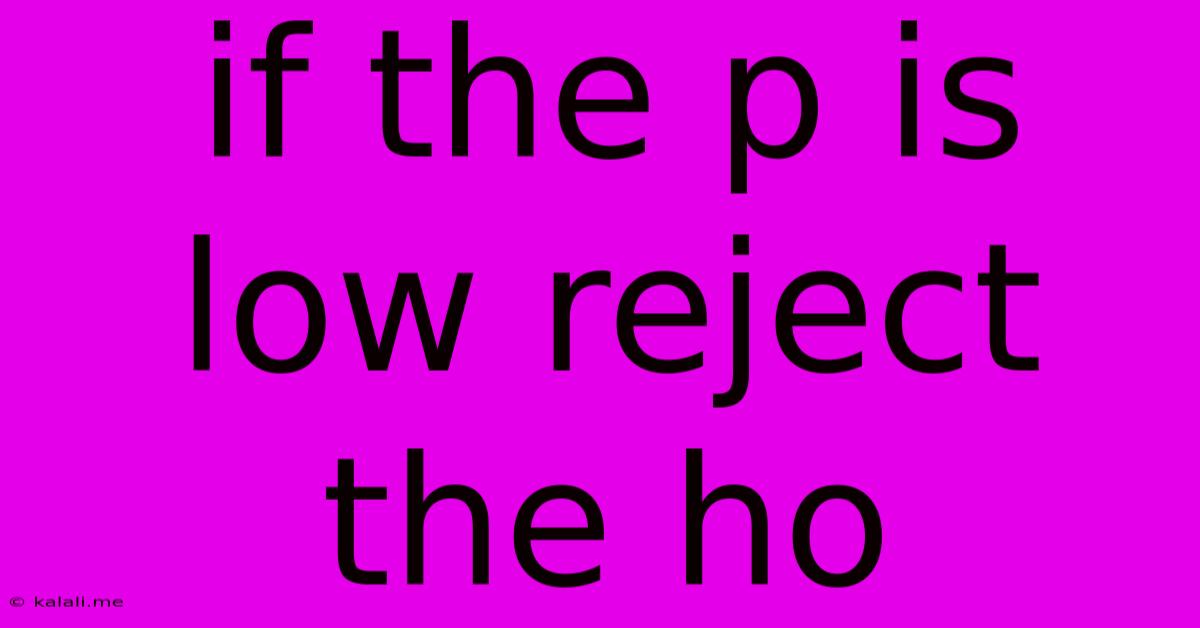If The P Is Low Reject The Ho
Kalali
May 24, 2025 · 3 min read

Table of Contents
If the P is Low, Reject the Ho: Understanding P-values in Hypothesis Testing
This article explains the core concept of p-values in hypothesis testing, demystifying the phrase "if the p is low, reject the Ho." We'll explore what p-values represent, how they're used to make decisions about hypotheses, and the importance of understanding their limitations.
What is a P-value?
In statistical hypothesis testing, the p-value is the probability of obtaining results as extreme as, or more extreme than, the observed results, assuming the null hypothesis (Ho) is true. In simpler terms, it quantifies the evidence against the null hypothesis. A low p-value suggests that the observed data are unlikely to have occurred if the null hypothesis were true. This leads to the common interpretation: if the p-value is low, reject the null hypothesis.
Null Hypothesis (Ho) and Alternative Hypothesis (Ha)
Before diving into p-values, we need to understand the two types of hypotheses:
- Null Hypothesis (Ho): This is the default assumption, often stating there's no effect or no difference between groups. For example, in a drug trial, the null hypothesis might be that the drug has no effect on the disease.
- Alternative Hypothesis (Ha): This is what you're trying to prove. It's the opposite of the null hypothesis. In the drug trial example, the alternative hypothesis might be that the drug does have an effect on the disease.
The Decision-Making Process
The process of hypothesis testing involves comparing the p-value to a pre-determined significance level (alpha), usually set at 0.05 (5%).
- If p ≤ α: The p-value is less than or equal to the significance level. This indicates strong evidence against the null hypothesis. We reject the null hypothesis (Ho) and accept the alternative hypothesis (Ha). This suggests the observed results are statistically significant.
- If p > α: The p-value is greater than the significance level. This suggests that there isn't enough evidence to reject the null hypothesis. We fail to reject the null hypothesis (Ho). This doesn't mean we accept the null hypothesis as true, but rather that we lack sufficient evidence to reject it.
Important Considerations and Limitations
While "if the p is low, reject the Ho" is a helpful rule of thumb, it's crucial to understand the limitations of p-values:
- P-values don't measure the size of the effect: A statistically significant result (low p-value) doesn't necessarily mean the effect is large or practically important. A large sample size can lead to a statistically significant result even for a small effect.
- P-values are influenced by sample size: Larger sample sizes increase the power of the test, making it more likely to detect even small effects, potentially leading to a low p-value even when the effect is not practically meaningful.
- P-values don't prove the alternative hypothesis: Failing to reject the null hypothesis doesn't mean the null hypothesis is true. It simply means there's not enough evidence to reject it. Similarly, rejecting the null hypothesis doesn't definitively prove the alternative hypothesis.
- Multiple testing: Conducting many hypothesis tests increases the chance of finding a statistically significant result by chance alone (Type I error). Adjusting for multiple comparisons is crucial to avoid false positives.
Conclusion:
The phrase "if the p is low, reject the Ho" provides a simple way to interpret p-values in hypothesis testing. However, it's vital to remember that p-values are just one piece of the puzzle. A comprehensive understanding of the context, effect size, sample size, and potential biases is crucial for drawing meaningful conclusions from statistical analysis. Relying solely on p-values without considering other factors can lead to misinterpretations and flawed conclusions. Always consider the practical significance of your findings alongside the statistical significance.
Latest Posts
Latest Posts
-
What Is The Major Reason That Atoms Join Together
May 24, 2025
-
I Will Have War With Amalek
May 24, 2025
-
On Your Mark Get Set Go
May 24, 2025
-
How Do You Get Gas Smell Off Hands
May 24, 2025
-
The Square Of Sum As Integral
May 24, 2025
Related Post
Thank you for visiting our website which covers about If The P Is Low Reject The Ho . We hope the information provided has been useful to you. Feel free to contact us if you have any questions or need further assistance. See you next time and don't miss to bookmark.